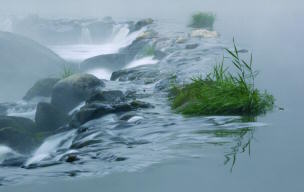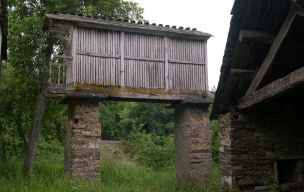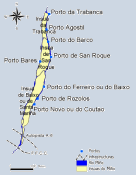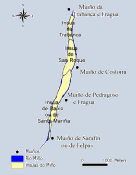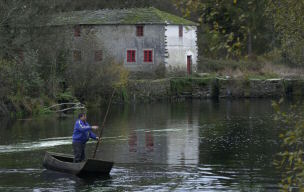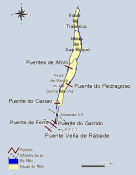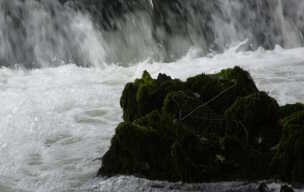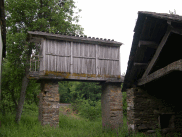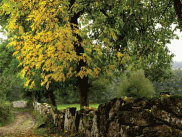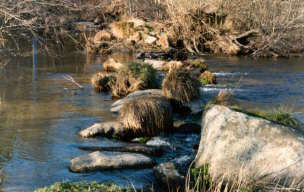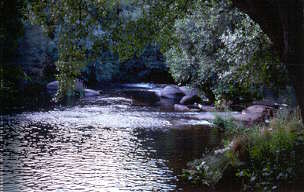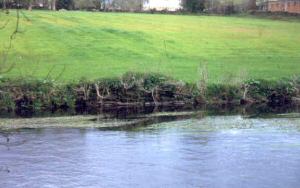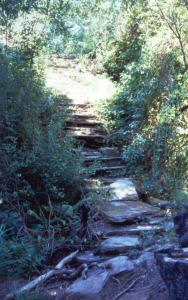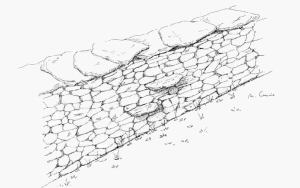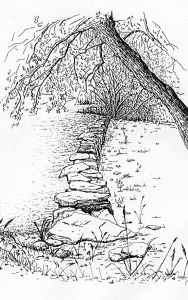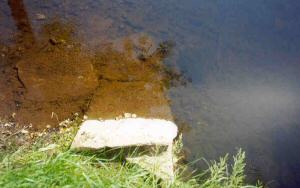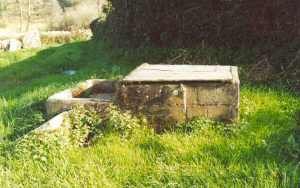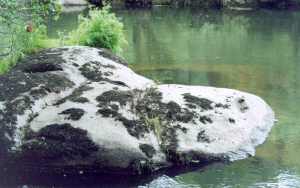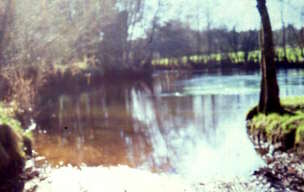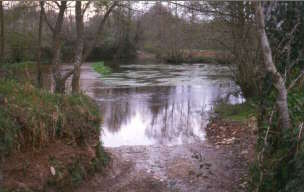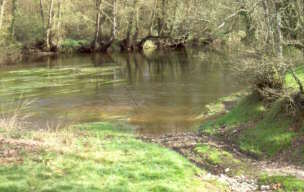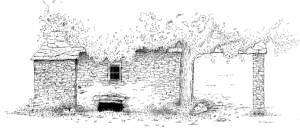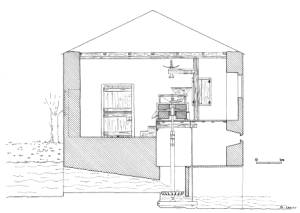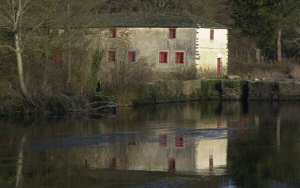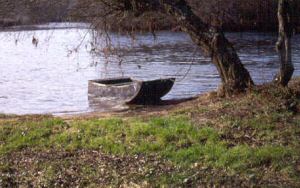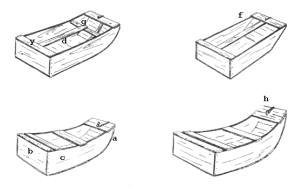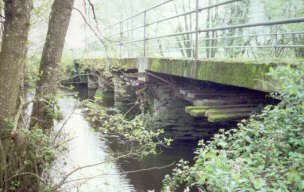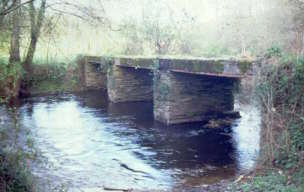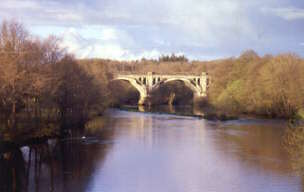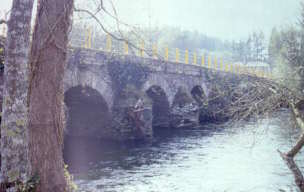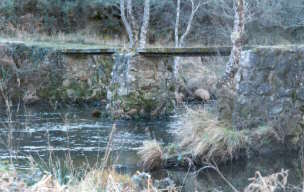
|

| INTRODUCTION | |||||
|
The Miño River Basin evokes past times in which Man and River lived as one. There was a water related culture with legends like the "xacio", the "half man half fish", or in traditional buildings where the power of the river was and is harnessed via an ingenious system of canals to drive mills and "mazos" (blacksmiths). |
|
Here one can find weirs, islands and woods. The banks are areas for communication and an example of ancient sustainability. Different kinds of bridges, "pontellas" (little bridges), walks and moorings bear witness to this as does the use of a traditional flat bottomed boat the “batuxo”, all of which make up the ethnographical variety present in the area. |
|||
| "PONTELLAS" | |
|
Pontella da Insua do Curro (Curro Island Pontella): Here there is a small bridge in San Xulián de Bocamaos parish, in Vilar there is a "pontella" (little bridge), swhich crosses from Insua do Curro to the mill dam by the old church. It used to have a wooden floor based on chestnut beams. Now it has a sluice gate for Penas Mill. |
|
| THE ISLANDS
The islands or “insuas” (river islets) these “green hearts” in the river are fertile plots of land which throughout time have fed cattle, provided firewood and timber for boats and tools. The islands usually have alder, birch, oak and chestnut trees, all native species felled to make room for pasture or hay. The Miño Islands make up part of the SCI and Terras do Miño Biosphere Reserve. Submerged when flooded, they provide shelter for a lot of aquatic flora and fauna. Canals, ponds, and interior lakes, water plants, leafy woods full of alder, oak, birch, moluscs such as the mussel or river pearl, and animals like roebuck and heron make these islands a real sanctuary for Miño wildlife.
"Facéndolle as beiras ó Miño" |
|
PASSING PLACES
These were a system of irregular stones, sometimes prisms, placed in the stream or river in a haphazard way with no definite number dependeingon the width, current etc |
|
| 1. |
River Narla in the Parish of San Martiño de Ombreiro.
Just different sized stones placed over the river with a person´s stride space between them, this is a shallow river so the aim is not to get your feet wet more than to resist the current. |
| 2. |
Marcelle in the parish of San Martín de Guillar has the passing place Insua de Abaixo.
They are between the old mill and Albariza weir made with stones dug into the river which now look like a little dam as they have been filled to make a bathing place. They are very beautiful because with the passing of time the rounded stones take on irregular sculpted shapes. "Facéndolle as beiras ó Miño" |
TRADITIONAL BUILDINGS |
|
|
On the banks of the Miño and its numerous streams, one can´t help noticing certain “buildings”, walls, sheds, steps, fences, saltadoiros and one is amazed at their natural beauty. All this is a result of neccesity and also the architectural ingenuity and aesthetic sense of the inhabitants.
Miño River Bank Walls Whatever use the banks were put to, the inhabitants couln´t allow the river to erode the earth from the banks and so constructed stone walls of varying lengths, a practicethat was forbidden. These walls were necessary on the outside of the bends to protect them from the erosion of the river itself, but on straight stretches it was to gain more land. The properties on the banks, usually meadows, were closed off so cattle wouldn´t wander into their neighbours fields and also perhaps to mark off properties often with slabs or typical stones from this area. In this kind of wall there are real works of art.
In other cases the slope was so steep that it had to be levelled off and so steps were built in the meadows to walk down more easily. The walls reach the water´s edge and as there were rights of way there were different solutions, the most common are the saltadoiros. |
|
|
If they were made of rubblework then one or two stones were put each side as steps so that it was like going up stairs. It was difficult to go far without finding one of these and today many are well kept, taking into account that nobody goes there on foot.
The fields were closed off with wooden gates and often a stick wth gorse was used so cattle wouldn´t wander above all at harvest time. Gates for carts,carrilleiras, were often left open to make it easy to enter with the cart. |
|
|
WASHING PLACES Taking into account the fact that washing machines have only been used recently, it´s easy to imagine how important washing places were in the rivers and streams as there wasn´t running water in the houses. In the river Miño there were many on the bankswhere women would go with baskets on their heads or zinc buckets, in more modern times.
|
|
|
In Cela there are some individual ones as many of the houses are parallel to the river and the fields go down to the river.
|
|
|
BATHING PLACES There is little to say about bathing places and customs in the Miño as baths with restorative powers or superstitions are generally related to the sea or with fountains or special streams which had properties due to their components or whatever popular circumstances were attributed to them.
“Fondapaus” Rock Every village or hamlet had a special place for bathing. Today people enjoy the waters in Cela, in the islands, in Rábade by the bridge, in Outeiro above the Pena weir, in Sta. Isabel, in O Piago de Robra, in Ombreiro, a place for swimming and snacking, in Insua de Meilán and in the Puente Nuevo in Lugo. "Facéndolle as beiras ó Miño" |
|
|
FORDS
Fords or "Portos" are the places used for boats to transport people, cattle or carts. They are normally called after the place where they are situated belonging to the owner of neighbouring fields or after some event.
|
|
| 1. |
Porto da Trabanca (Trabanca Ford): In the place of the same name in Santa María de Cela (Outeiro de Rei) this is one of the passes to Insua da Trabanca, in summer you can cross on foot.
|
| 2. |
Porto de San Roque (St. Roque Ford): This is a crossing place for Insua de San Roque , still in use in thesummer instead of oxe carts or cows, hay makers cross over and occasionally a donkey cart for hay.
|
| 3. |
Porto de Barés (Barés Ford): belongs to the parish of Saavedra (Begonte). It is on the right hand bank which some call the Miño and others Barés and is also a ford for Insua de San Roque.
|
| 4. |
Porto de Santa Isabel (Sta. Isabel Ford). Opposite the mill of the same name over the Miño is this ford used above all by those who come from Martul and other parishes.
|
| 5. |
Porto de San Xillao (St. Xillao Ford)was a ford between San Xillao in Bocamaos (Lugo) to Parada (Outeiro de Rei) via the Camino Real.
|
|
All these fords were very important either for boats from one bank to the other. "Facéndolle as beiras ó Miño" |
|
"MUIÑOS" - WATER MILLS |
|
|
|
Muiño do Rego do Pedragoso. Rego do Pedragoso. Cela, Outeiro de Rei - Lugo |
|
|
Galicia, land of a thousand rivers, can be considered the land of watermills. Every river, stream or brook has its mill. The Parga-Ladra-Támoga SCI shows this. Mills can be seen on the banks built directly over the river with the river flowing through weirs or a few metres away carrying the water which drives the wheels through artificial canals. Theirs is a simple square design with one or two floors with the door at ground floor level or with a slightly raised doorstep (a stone forming the bottom of the door). Two or four angle roofs, plastered inside and out, sometimes with dove cotes, outbuildings. (“Alpendres” are buildings used to house carts or cattle while corn was being milled. They have roofs and are generally open at the front situated next to the mills near the entrance. The miller´s house and sheds are also next to the mills or separate buildings. The little “pontellas” or bridges cross the canals taking the water to the mill or take what´s not used back. )They have “pousadoiros”, corner stones joined to the front of the building (to support the load), cruxifixes, marks in doors or inside, crosses to protect the mill and its business and other accesories like irong rings to tie up the loaded carts. Big mills had big windows and doors, little ones had little windows and doors for light and ventilation. They looked on the hellish activity. Their size depended on the number of millstones, these were on the top. Some of the most important mills in Parga-Ladra-Támoga SCI area are: |
|
MUÍÑO DE FELPÁS (FELPÁS MILL) |

|
|
This is in Felpás the parish of Santa Mariña municipality of Outeiro de Rei near San Roque island. Built about 1840. |
|
It was known as an “aceña”. Some mills (Sampedro 1990) (Barros Justo) were so called which stored water to increase the river level and so power the wheels. They usually had between two and four stones. The Felpás, A Trabanca and Sta. Isabel mills all in the Parga-Ladra-Támoga SCI had 4 stones for millimg. A Trabanca had 5, in Felpás 3 were French, the first, third and fourth from the entrance)used for bread cereals (wheat)and one local one (second) for corn, barley etc. Their diameter is 1, 20 m and in Rábade (electric) and Sta. Isabel, 1. 30. In Felpás the local wheels milled both food and rye for cattle and bread cereal with worse quality flour, coarser and less pure. |
|
MUÍÑO DE SANTA ISABEL (STA. ISABEL MILL) |
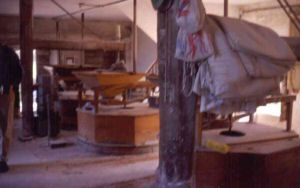 |
In Santa Isabel, Outeiro de Rei, Lugo Built in the last decade of the 19th century 1898. On the left bank of the Miño where it moves to the right just where the River Ladra joins it, so seeming to form an island. |
|
MUÍÑO DA PONTE (DA PONTE MILL) |
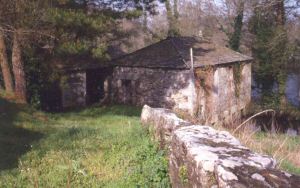
|
This is on the right bank of the Ladra once we have passed Uriz. It belongs to the parish of Santiago de Gayoso in Outeiro de Rei. An inscription in the door lintel dates back to 1888. The mill is on the bank itself with the back built into the dam which has impressive stones fishing posts where a lot of fish were caught, mainly eels. It´s easy to get to once we cross Uriz bridge we turn right and enter the property formed by the mill, a very large house. |
|
|
MUÍÑO DE TRABANCA (TRABANCA MILL) |
"Facéndolle as beiras ó Miño" |
BOATS - THE “BATUXO”. |
||||||||||||
|
For a long time nobody could imagine the life of the river bank people without their boats. They were often the only means of transport between the parishes and Lugo, the walled city. Therefore there were as many kinds of boats as needed. The “Batuxo”.
The most well known but not the most used. Its owners prefer to call it “barco, barqueta” or “barquixolo” because it´s the smallest but has survived longest. Materials Any wood will do but the most frequently usedare:
Description.
Parts of the “batuxo” and accessories.
The total length of the boat is 1, 80-2 m. , bearing in mind that the measurements vary from one “batuxo” to anotherand from one area to another. Oar Made of alder wood or birch it is 2, 5-3m. Wide. It is usedas a pole by one person who stands up in the rear of the boat, pushing it into the river bed to power the boat. During floods when the oar didn´t reach the bottom you could carry out an “apalexo”, standing up at the rear one moves the oar as if in a canoe. Use
|
||||||||||||
"Facéndolle as beiras ó Miño" |
||||||||||||
|
|||||||||||||||||||
| ORAL TRADITION | |
RIVER MIÑO LEGENDOnce upon a time there was an old, ugly witch married to an old man. They often argued. This time they argued more than usual. The witch said that if he looked behind him when he ran away she would curse him. He started to run away and looked behind himto see if the witch was after him. The witch began her curse and the man saw soe birds come near and began to throw stones. He ran downhill and the witch laughed aloud. One of the stones knocked him out, they caried onthrwing and he was buried under the stones. Blood flowed from the stones which changed into a never ending suply of water, a fountain under the stones and there was born a river which later was called the Miño. (Heard in Meira, Miuzallas magazine, 1999 published by “Estiño” collective. ) RIVER MIÑO LEGENDAccording to the legend, when the Virgin arrived in the world with her child, she came to the banks of the Miño. The current made a loud noise which woke the child up a he cried loudly. His mother didn´t know what to do and said to the river:/p> River Miño
(Heard in A Ponte area, Miuzallas magazine 1999 Estiño Collective) WHAT HAPPENED TO A TROUT FISHERMAN IN CELADuring the nine days of mass in honour of Santa Isabel, Manuel María, a devotee of this saint, tells us of the following on the first day : “People in Outeiro de Rei tell the story of what happened years ago to a trout fisherman in Cela. He was fishing in his batuxo in As Veigas or Campo de Sta. Isabel. When his net was full it split and the fishescaped. He was desperate and began to blaspheme against Our Lord, the Virgin Mary and her cousin Isabel. Suddenly the “batuxo” capsized and sank to the bottom, dragging the fisherman down. Try as he might he couldn´t get the batuxo off him and get to the surface. In anguish he thought of Sta. Isabel to whom his mother had offered him as a boy. At once the batuxo emerged in its normal posiion completely dry, and with it the fisherman safe and sound, so full of fish they could hardly fit.” (Published by Cultural Association “Xermolos” of Guitiríz. ) THE LEGEND OF THE SNAKEI don´t know if this is really a legend but in the municipality of Outeiro de Rei there is a “curro”, steep slope, called “El Tuxo” where there lived a big snake with wings. It would leave the Raxul area (near O Piago) and would fly to Sta. Isabel then it would stay in El Tuxo and frighten us children passing by with cattle. They later told us it was a tale invented by a certain Manolo who also said he caught 5 Kg. of eels, we used to believe this more because it suited us to, but now 30 years later we find other people who tell us the same story of the winged serpent so this legend must have existed a long time ago. SAN LÁZARO LEGENDThe Sunday before the celebration of Saint Lazarus is the one before Palm Sunday and it often rains at this time. The people of A Ponte (the area around the Bridge) were sick and tired of getting wet in this fiesta so they tried putting the Saint in the river. Suddenly the sun came out. ((Heard in the A Ponte-Revista Miuzallas-1999. Estiño collective) THE TROUT SPOT LEGENDMany years ago there was a trout spot in Francos on the River Miño. Every week the trout went to the village to feed and when there was no food it would eat a man. Nobody went to the river where the trout was. It was said that he changed people into thin pigs and ate them. On Wednesdays the trout would visit the blacksmith for him to scratch his back for it was very spotty and in exchange he would give a bag of gold coins. One day a brave man went there and emptied a barrel of acid while the trout was at the blacksmiths. When he got back, he went to the spot and burnt his skin and stomach. People are still frightened he will come out and eat them. (Francos-Lousada. Miuzallas magazine 1999 “Estiño” collective)
THE LEGEND OF THE DEVIL´S “CANEIRO” (WEIR)The old people say that the weir was made by thedevil himself and that he had left it with crooked jaws. As it was dangerous to get the nets ready here they decided to straighten the entrance but then the eels escaped and they had to rebuild them as crooked as before, which made more people believe in the legend. (Heard in Ombreiro a Darío Rodríguez, 21-5-2000)
Riddles, Refrains and Popular Sayings
RIDDLESFrom Paco Martín´s book "¿Qué cousa é cousa...?" About the wheel
About the mill -Anda e non ten pés
Somehow related related to the mill (miller, noise, water, wheat... ) -¿Que cousa ten o muíño,
About the river and fish : -Estando eu na miña casa
The following is Alfonso Magariños´riddle: Longo coma unha rúa
REFRAINS
- Para a misa e para o muíño, non agardes polo veciño . (Never wait for your neighbour for mass or for mill). - Cambiarás de muiñeiro pero non de ladrón . (You can change your miller but not your thief). (Pastor. 11-1-2000. Molino de Serafín o de Felpás. Felpás. Santa Mariña. Outeiro de Rei) - Pescador e troiteiro nin muda nin palleiro . (A troutfisherman has neither spare clothes nor hayloft). - No inferno só había taberneiros e muiñeiros, un por medir pouco e outro por medir moito. ( Hell only has inn keepers and millers, one to measure too little and the other, too much). (Pastor. 11-1-2000. Molino de Serafín o de Felpás. Felpás. Santa Mariña. Outeiro de Rei) - Polo San Lucas suca boi suca . (Around San Lucas the oxe ploughs).
POPULAR SAYINGS-“We used to say : the cows are going to “mollón” (hay) , ” then we could drink their milk. There is a riverside herb called allariga , which tastes of garlic and when the cows grazed there it tasted of garlic...” (Heard in Ombreiro from Dario Rodríguez 21/5/200’, speaking about grazing on the “Mollóns”) - We used to say “ the miller steals, but he who enters is a thief ” because nobody goes into the mill without getting covered in flour. The flour isn´t yours, careful how you shake it off, so if you take what isn´t yours, you´re a thief. (Recogido en Orbazai a Manuel Fernández el 30-1-2000)
-“ Pena da Costureira ”, is near Pacios weir. They have a recommendation, when the river is full and covers the rock, you shouldn´t cross. The rock is so called because a witch used to darn there and when the water covers it you shouldn´t cross the river. (Heard in San Xoan de Parada from César Ferreiro 23/8/20000) - When the weir was noisy it was icy, when it wasn´t it was fine. If you could hear the train from the weir, then it was going to be frosty. (Manuel Fernández -Orbazai, 30-1-2000)
- The lazier the miller, the better. (February 2000. Muíño de Santa Isabel. Santa Isabel. Outeiro de Rei. Lugo) : An old man from Sta. Mariña said this because the miller´s rhythm affects the milling and the flour isn´t good for breadmaking. ParrafeosA CONQUISTA DE CARMIÑA
-Carmiña do meu agrado
(Recogido en Cela-Outeiro de Rei el 27 de octubre del 2000) Cantigas (cantares)-Miña nai non quere que vaia ó muíño
In the following "cantigas" (popular poetry) one refers to the mill. The other does not, it was heard near the river Rato, in Cela and was sung by the grandmother of our sources: Eu non sei que pasou no muíño,
"Facéndolle as beiras ó Miño" |
| POETRY | ||
|
||



